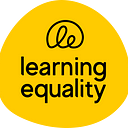Open Models for Just-in-Time Learning Pathway Recommendations
In March 2019, Learning Equality co-convened a two-day design sprint in Paris in collaboration with UNHCR, Google.org, Vodafone Foundation, and UNESCO. We explored the need for automated curriculum alignment in crisis contexts, and the possible role of artificial intelligence (AI) in recognizing curricular mandates and patterns, and recommending pertinent educational content in return. This work is part of a broader collaboration working with refugees and partner organizations to explore utilizing digital education to support learning in these contexts.
The Design2Align series has included discussion of contextual display and creation of metadata, teacher-generated content annotations, and the technical considerations in OER for curriculum alignment facilitation. We’re delighted to introduce the fourth installment of the blog series by our co-founder and Executive Director, Jamie Alexandre. Jamie discusses how user data from multiple open platforms could be used to train machine learning models, in order to optimize recommendations to teachers of contextually relevant learning pathways for their students.
Our table brought together participants from diverse backgrounds and skill sets, spanning government, foundations, the tech industry, education nonprofits, and UN agencies, which made for some lively debates! The broad theme for our group was “Open Platforms”, and we set out to tackle the following challenge:
Especially in refugee camps, students and teachers come from diverse backgrounds and educational levels. Teachers have limited preparation time, and serve large class sizes, and students have limited access to technology-enabled classrooms for direct access to open learning resources. A large number of open educational materials are available for some topics, and in some cases they are roughly aligned to curricular standards. However, these materials are often not grouped into student-specific learning pathways, making it difficult to support students in achieving their learning objectives.
A significant challenge, but where to start? One of the key questions we initially considered was how user data from multiple open learning platforms (e.g. records of student interactions with assessments and other content) can be used to train machine learning models to better suggest contextually relevant content to curators, teachers, and students. At first glance, this sounds like a standard adaptive/personalized learning system, but we wrestled with the fact that in the “open platforms” ecosystem, this user data may be fragmented amongst several platforms and systems, and would need to be shared or consolidated in order to train effective machine learning models.

The privacy of user data is vital to protect, particularly when we’re working with vulnerable populations such as refugees who may be fleeing from persecution or violence in their home country. A standard method of anonymizing user data is through aggregation, meaning data from many users is summarized through averages, counts, or other methods. However, the more you aggregate, the less valuable the data becomes for training predictive models, thus defeating the original purpose. As a result, we explored ways in which data could be leveraged across platforms so as to retain as much predictive power as possible while also protecting users’ privacy.
One key idea we considered was building a set of standardized open-source tools that could be used within each organization’s platform to train a predictive model that could then be shared across organizations and combined with the other models in an “ensemble method”, to enable predictions that leverage the underlying data from each organization’s platforms without putting their users’ privacy at risk. These trained models would then be listed in a public database, along with high-level metadata around underlying user characteristics and modalities of the platform in which the learning activities took place. This database could also include mechanisms for peer-contributed feedback on the predictive value of the various models for particular contexts, enabling platforms to decide how to combine a subset of the models together to best serve their own purposes.
We then shifted tracks, focusing in on a specific use case of these predictive models: to help teachers quickly discover open resources, mapped into learning pathways, to support the learning objectives of an imminent class period. The system would recommend a set of learning pathways for each grouping of students, with the grouping process taking into account their different levels and diverse backgrounds based on their past performance.
Given the limited time that teachers in these contexts often have to prepare for a class, they would not be required to customize the pathways for each student individually. These pathways would be targeted towards helping each group of students achieve the specified learning objective, but with different starting points, prerequisite materials, or additional activities based on the needs of that group. Teachers could then, if time allowed, customize and adapt the pathways, or move students between the groups, based on their knowledge of the students. Teachers would also be guided towards activities they could facilitate with each of the groups, to help to fill in any content gaps in the learning pathways. Finally, teachers could document and share the activities they conducted, thereby creating new learning resources for use by other teachers.
By the end of our session together, we had learned a lot from each other, planting the seeds for ideas that we hope will continue to grow and flourish across our respective work, and in our future collaborations with one another.
Follow the hashtag #design2align from October 16–18, 2019 for all updates from the hackathon event in San Francisco, aimed at prototyping a tool to automate parts of the curriculum alignment process, making it more readily available and feasible for use by countries in emergency contexts. The Design2Align Hackathon is a collaboration between Learning Equality, UNHCR, Vodafone Foundation and UNESCO with the support of Google.org.
And stay tuned for the next post in the series, where we explore the applications of AI for Evaluation and Assessment processes.

